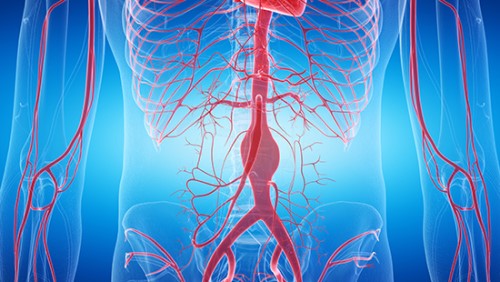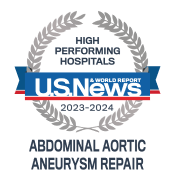Aortic Aneurysm

An aortic aneurysm is an abnormal expansion or bulging of a portion of the aorta due to weakness in its wall.
Several disease processes can weaken the wall of the aorta over time. These weakened areas can expand, like a balloon.
The aorta, the largest artery in the body, starts at the top of the heart, passes over the heart in an arch, then travels down to the lower abdomen.
Along the way, it has many branches that supply blood to vital organs, your arms and legs.
Aortic aneurysms can form:
- In the chest, known as a thoracic aortic aneurysm
- In the abdomen, known as an abdominal aortic aneurysm
- Throughout the length of the aorta, known as a thoracoabdominal
As an aneurysm grows larger and larger, the aorta can tear partially (aortic dissection) or completely through the wall and blood can leak out. This is a life-threatening condition and most often requires an emergency intervention or it can result in death.
At the University of Maryland Center for Aortic Disease, our aortic disease specialists can assess patients and put them on a fast track for surgery, if necessary.
Causes of Aortic Aneurysms
One of the common causes is atherosclerosis – a buildup of fatty plaque causing hardening of the arteries.
Other causes include:
- Genetic syndromes such as Marfan syndrome, Ehlers-Danlos Syndrome, Loeys-Dietz syndrome and Turner syndrome
- Inflammation of the aorta from blood vessel disease or infections
- Injury to the aorta from falls or auto accidents
Risk factors include:
- Smoking
- Aging
- High blood pressure
- Being male
- Hardening of the arteries
- Genetic factors
Symptoms and Diagnosis
Aortic aneurysms develop slowly over years, often with no symptoms.
They are often detected during other routine tests.
Most people will not have any symptoms until the aneurysm is very large or it begins to leak.
If it develops into a rupture, symptoms can include:
- Sudden, severe or tearing pain in the chest, back, neck, arm, abdomen or between the shoulder blades
- Clammy skin, nausea and vomiting
- Dizziness and passing out
- Rapid heart rate, very low blood pressure or death
Aortic Aneurysm Treatment
Treatment is determined by:
- Size of the aneurysm
- Presence and severity of symptoms
- Risk of surgery
Regular monitoring
Smaller aneurysms do not require surgery, but close observation is necessary to monitor its growth. Depending on the type of aneurysm, your doctor may want to check the size of the aneurysm with diagnostic imaging tests every six months to two years to determine the risk of bleeding from the aneurysm.
Surgery
If you have bleeding inside your body, you will need surgery right away.
A surgical procedure also may be necessary when the aorta is at risk of tearing open or when there is evidence of an impending rupture. The goal is to do the surgery before complications develop.
Conventional Surgery
In this repair, a surgeon stops the blood flow in the aorta above and below the aneurysm. This may require the use of a heart-lung bypass machine.
The section of the aorta with the aneurysm is then replaced with an artificial graft (a durable fabric tube). The graft is sewn in place with fine stitches and the incision is then closed.
Patients are monitored in the intensive care unit (ICU) after the surgery and will require a hospital stay of at least 7-14 days.
Endovascular Aortic Aneurysm Repair
In this procedure, a surgeon will make an incision in the groin, then insert and place a fabric covered metal or plastic tube (stent) at the site of the aneurysm.
This stent provides a new pathway for the blood flow at the site of the aneurysm. It will also prevent further expansion of the aneurysm and will keep the aorta from rupturing.
Patients are closely monitored after surgery and usually have shorter hospital stays than with conventional surgery. However, not everyone is a candidate for the endovascular treatment.
This technique requires continued monitoring with CT scans every 6-12 months following discharge from the hospital to look for problems with the stent graft.
TAMBE: A Promising Treatment for Aortic Aneurysm
Aortic aneurysms are dangerous and difficult to treat. Endovascular repair of aortic aneurysm with the TAMBE device is a promising new treatment that’s currently in clinical trial at the University of Maryland Medical Center. It has the potential to offer a new option for patients suffering from this dangerous vascular condition. Dr. Shahab Toursavadkohi, Associate Professor of Surgery at the University of Maryland School of Medicine and Co-Director of the University of Maryland Center for Aortic Disease, explains how it works.

